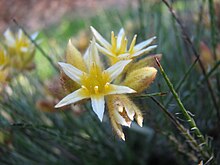| Conostylis setigera | |
|---|---|

| |
| In Maranoa Gardens | |
|
Scientific classification
| |
| Kingdom: | Plantae |
| Clade: | Tracheophytes |
| Clade: | Angiosperms |
| Clade: | Monocots |
| Clade: | Commelinids |
| Order: | Commelinales |
| Family: | Haemodoraceae |
| Genus: | Conostylis |
| Species: | C. setigera
|
| Binomial name | |
| Conostylis setigera | |
Conostylis setigera, commonly known as bristly cottonhead, [2] is a rhizomatous, tufted perennial, grass-like plant or herb in the family Haemodoraceae and is endemic to the south-west of Western Australia.
Description
Conostylis setigera is a rhizomatous, tufted, perennial grass-like plant or herb that typically grows to a height of 5–36 cm (2.0–14.2 in). It has flat leaves 80–360 mm (3.1–14.2 in) long, 1–4 mm (0.039–0.157 in) wide, green with striations and glabrous apart from several ranks of hairs on the edges. The flowers are borne in a head of 5 to 10 flowers on a flowering stem 40–200 mm (1.6–7.9 in) long. The flowers are yellow and woolly-hairy with lobes 5–9 mm (0.20–0.35 in) long. The anthers are 2.0–3.5 mm (0.079–0.138 in) long and the style is 6–11.5 mm (0.24–0.45 in) long. Flowering occurs from August to November. [2] [3] [4]
Taxonomy and naming
Conostylis setigera was first formally described in 1810 by Robert Brown in his Prodromus Florae Novae Hollandiae et Insulae Van Diemen. [5] The specific epithet (setigera) means "bearing bristles". [6]
In 1987, Stephen Hopper described 2 subspecies of C. setigera in the Flora of Australia and the names are accepted by the Australian Plant Census: [3]
- Conostylis setigera subsp. dasys Hopper [7] has leaves with shaggy hairs and flowers between October and November. [3] [8]
- Conostylis setigera F.Muell. subsp. setigera [9] has glabrous leaves, except on the edges, or sometimes with a few sparse hairs, and flowers between August and October. [3] [10]
Distribution and habitat
This species of conostylis is widespread and common in Western Australia growing in sand, loam, gravel an laterite in the Avon Wheatbelt, Esperance Plains, Geraldton Sandplains, Jarrah Forest, Mallee, Swan Coastal Plain and Warren bioregions of the south-west of Western Australia. [2] [3] Subspecies days is restricted to areas near Kojonup in the Jarrah Forest bioregion. [3] [10]
Conservation status
Conostylis setigera is listed as "not threatened" by the Western Australian Government Department of Biodiversity, Conservation and Attractions but subsp. dasys is listed as " Threatened Flora (Declared Rare Flora — Extant)" by the Western Australian Government Department of Biodiversity, Conservation and Attractions. [8]
External links
References
- ^ "Conostylis setigera". Australian Plant Census. Retrieved 23 February 2024.
- ^ a b c "Conostylis setigera". FloraBase. Western Australian Government Department of Biodiversity, Conservation and Attractions.
- ^ a b c d e f Hopper, S.D; Purdie, R.W; George, A.S; Patrick, S.J. "Conostylis setigera" (PDF). Australian Biological Resources Study, Department of Agriculture, Water and the Environment. p. 88. Retrieved 20 February 2024.
- ^ Hopper, S.D; Purdie, R.W; George, A.S; Patrick, S.J. "Conostylis setigera". Australian Biological Resources Study, Department of Agriculture, Water and the Environment. Retrieved 22 February 2024.
- ^ "Conostylis setigera". APNI. Retrieved 23 February 2024.
- ^ Sharr, Francis Aubi; George, Alex (2019). Western Australian Plant Names and Their Meanings (3rd ed.). Kardinya, WA: Four Gables Press. p. 306. ISBN 9780958034180.
- ^ "Conostylis setigera subsp. days". Australian Plant Census. Retrieved 23 February 2024.
- ^ a b "Conostylis setigera subsp. dasys". FloraBase. Western Australian Government Department of Biodiversity, Conservation and Attractions.
- ^ "Conostylis setigera subsp. setigera". Australian Plant Census. Retrieved 23 February 2024.
- ^ a b "Conostylis setigera subsp. setigera". FloraBase. Western Australian Government Department of Biodiversity, Conservation and Attractions.